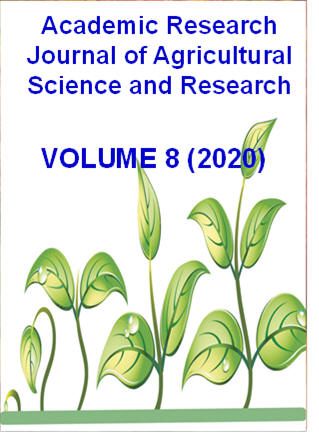|
ISSN: 2360-7874 |
Academic Research Journal of
Agricultural Science and Research |
|||||||||||||||||||
|
Vol. 8(2), pp. 128-136, March 2020 Research Effects of Blending ratio and lupine variety on the Functional Properties of composite flours and Sensory evaluations of tef-lupine injera
Lamesgen Yegrem1, Solomon Abera2 and Melese Temesgen3
1Debrezeit Agricultural Research Centre, EIAR, P.O. Box 2003, Addis Ababa, Ethiopia. 2,3 Department of Food Science and process engineering, P.O. Box 138, Haramaya University, Ethiopia Correspondence should be addressed to: E-mail: lamesyegrem@gmail.com, +251918541618
Accepted 15 March 2020
This study was conducted to investigate the effect of lupine flour on functional properties and sensory acceptability of tef-lupine blended injera. Injera is a staple food for Ethiopian and it is fermented, sour leavened pancake-like bread made from blending of different cereals like tef, barley, sorghum, maize and wheat. Besides, there are limited studies on formulating of injera from composite flour with legumes (lupine). The effect of two factors two lupine varieties (Australian sweet lupine and Dibettered lupine seed) and blending ratios. Maximum and minimum levels of independent variables were first investigated by doing a preliminary analysis and funded that tef from up to100- 80% and lupines from up to 0-20%. Response surface methodology was applied to find the formulations and predictive model. Sensory acceptance of tef-lupine injera was affected by interaction of varieties and blending ratios. Oil absorption capacity and swelling power properties of composite flour decrease as blending ratio of lupines increased and water absorption and foaming capacity increased as blending ratio of lupines increases for both varieties. As the sensory acceptability scores data indicated for both lupine varieties blended with tef for the production of injeras of up to 15% lupines almost all sensory attributes showed higher scores without significantly different among them but after 15% lupine addition there were observed drop of the sensory acceptability scores. In a 7 point hedonic scale, the composite sample tef injeras with 10% DLS addition had the highest scores of 6.09, 6.22, 6.09 and 6.18 in eye size, aroma, rollability and overall acceptability respectively. The L* value and number of eye by injera eye software were 72.77 to 79.84 and 14220.43 to 18929.33, respectively. The L values of blended injera increased as lupine proportion were increased, but the number of injeras eyes decreased.
Keywords: Dibettered lupine seed, Composite injera, Response surface methodology
How to cite this article (APA Style): Lamesgen Y., Solomon A., Melese T (2020). Effects of Blending ratio and lupine variety on the Functional Properties of composite flours and Sensory evaluations of tef-lupine injera. Acad. Res. J. Agri. Sci. Res. 8(2): 128-136
|
|||||||||||||||||||
